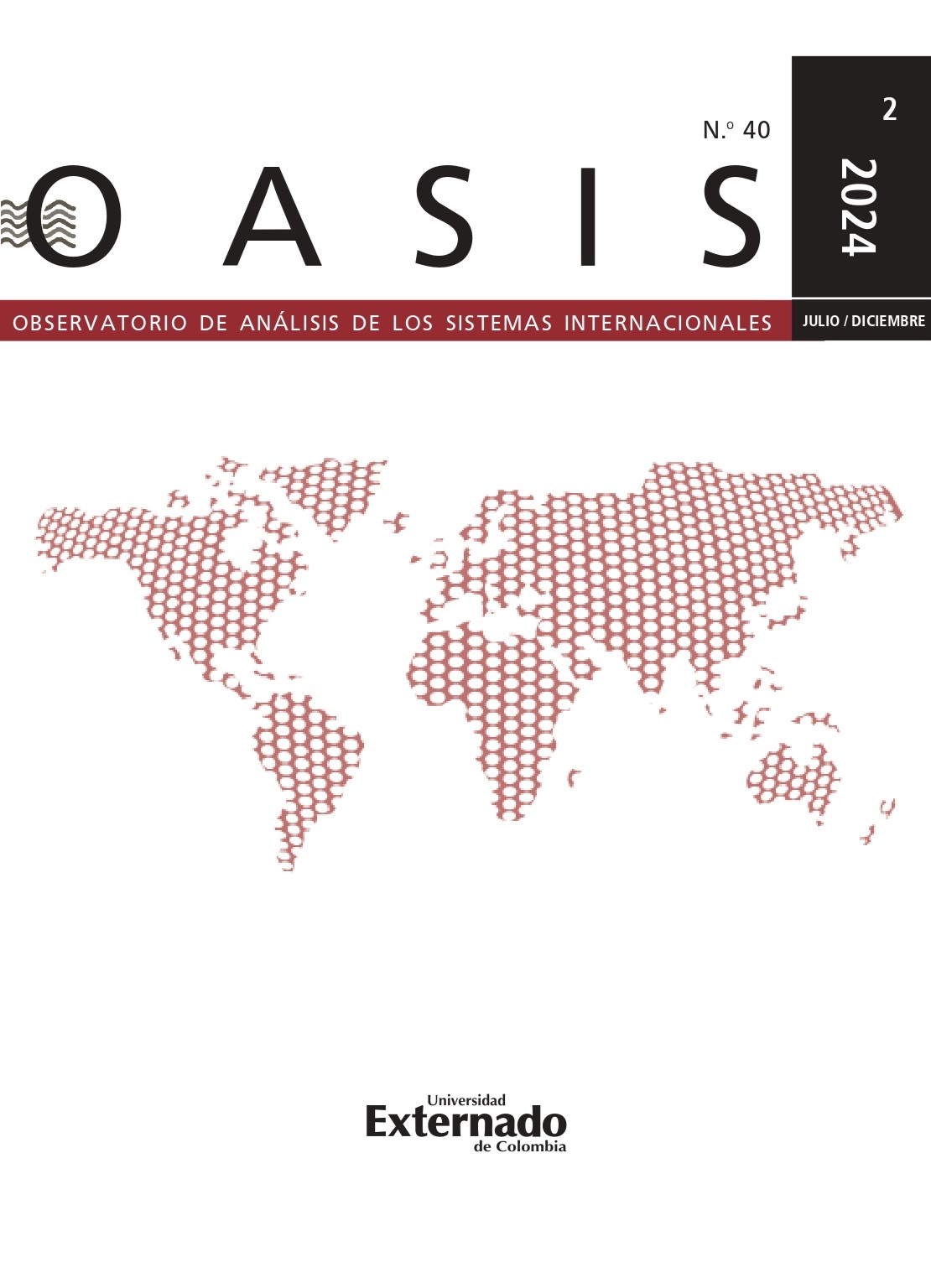Navigating borders and waters: India-China border disputes and the complexities of transboundary river management
Navigating borders and waters: India-China border disputes and the complexities of transboundary river management
Contenido principal del artículo
Resumen
Las controversias fronterizas, tales como las reclamaciones territoriales, la seguridad y la soberanía, desempeñan un papel importante en la gestión de los ríos transfronterizos. Las fronteras pueden actuar como barreras físicas que impiden la cooperación y la coordinación entre naciones, y las disputas sobre la propiedad y el control de los recursos fluviales pueden exacerbar las tensiones y derivar en conflictos. La gestión de los ríos transfronterizos es una cuestión compleja y crucial a la que, en los últimos años, se le ha prestado cada vez más atención. La gestión de los ríos que atraviesan fronteras internacionales plantea numerosos retos, entre ellos aspectos políticos, económicos, sociales y medioambientales. Una gestión eficaz necesita de la cooperación de todos los países que comparten la cuenca fluvial y requiere desarrollar marcos jurídicos e institucionales que promuevan el uso sostenible, el aprovechamiento compartido equitativo y la resolución pacífica de conflictos. El objetivo de este artículo es explorar la compleja relación entre las reiteradas disputas fronterizas entre India y China, y las consecuencias de mayor alcance para la gestión de los ríos transfronterizos. Sus disputas por conflictos territoriales no resueltos tienen profundas implicaciones para las cuencas fluviales compartidas, como la del río Brahmaputra, y plantean importantes desafíos a la hora de implementar estrategias eficaces para la gestión de los ríos transfronterizos. A través de un examen interdisciplinario de factores históricos, geopolíticos e hidrológicos, este estudio arroja luz sobre las polifacéticas dimensiones de las disputas fronterizas entre China e India, y esclarece sus perjudiciales repercusiones en el aprovechamiento de los recursos fluviales transfronterizos.
Descargas
Detalles del artículo
Referencias / Ver
Banerjee, M. (2022). Sino-Indian Border Dispute: A Brief Introduction. Asian Territorial and Maritime Disputes, 158. https:// s3.eu-central-1.amazonaws.com/eu-st01. ext.exlibrisgroup.com/27uoj_inst/stor-age/alma/87/87/D8/49/12/C4/40/F0/F6/5C/34/A9/7F/A1/58/0E/Ra e%20 Lana%20I srael%20-%20Understanding%20China%27s%20New%20As-sertiveness%20from%20Resolved%20Territorial%20Questions.pdf?response-content-t ype=appl ic at ion%2Fpdf&X-Amz-Algorithm=aws4-hmac-sha256&X-Amz -Date=20240419T054023Z&X-Amz-SignedHeaders=host&X-Amz-Ex-pires=119&X-Amz-Credential=akiajn6npmngjalppwaq%2F20240419%2Feu-cen-tral-1%2Fs3%2Faws4_request&X-Amz-Si gnature=2449905bb29651841ae5a4917970 ac28e53cf9424b218da500ad7d95f18c756a #page=169.
Baxi, G. D. (2011). China as Hydro-Hegemon: The Onset of Water Wars. Vivekananda International Foundation. https://www.vifindia.org/ article/2011/july/06/China-as-Hydro-Hegemon-The-Onset-of-Water-Wars#:~:text=%20China%20is%20the%20natural%20hydro-hegemon%20of%20Asia.,sometimes%20 around%20the%20middle%20point%20 of%20this%20century.
Central Water Commission (2020). Basin Details: Brahmaputra. Government of India. https:// cwc.gov.in/bbbo/about-basins.
FAO Aquastat (2011). Transboundary River Basin Overview – Ganges-Brahmaputra-Meghna. https://www.fao.org/3/CA2138EN/ ca2138en.pdf.
Feng, Y., Wang, W., & Liu, J. (2019). Dilemmas in and Pathways to Transboundary Water Cooperation between China and India on the Yaluzangbu-Brahmaputra River. Water, 11(10), 2096. doi: https://doi.org/10.3390/ w11102096.
Gautam, P.K. (2004). The Parechu Lake Incident: A Preliminary Analysis. Institute of Peace and Conflict Studies (IPCS). http://www.ipcs.org/comm_select.php?articleNo=1569.
Indo-Asian News Service, Shimla. (2005). Tibetan lake sparks panic in HP. Press Trust of India (PTI). https://www.hindustantimes.com/ india/tibetan-lake-sparks-panic-in-hp/story-kos6YjE8BR9F13IwWsApCJ.html
Jayaraman, K. (2004). Crisis foments as an unstable lake builds in the Himalayas. Nature, 430, 818. doi: https://doi.org/10.1038/430818a.
Joshi, M. (2022). Understanding the India-China Border. Harper Collins Publishers.
Lu, Y. (2007). Looking beyond the border: The Sino- Indian border dispute and Sino-Indian relations. Heidelberg Papers in South Asian and Comparative Politics, (31). doi: https://doi. org/10.11588/hpsap.2007.31.2199.
Maxwell, N. (1970). India’s China War. Jonathan Cape.
Ministry of External Affairs (n.d.). India-China Bilateral Relations. Government of India. https://mea.gov.in/Portal/ForeignRelation/ ind-china-new.pdf.
Ministry of Jal Shakti (n.d.). India-China Cooperation. Government of India. http://jalshakti-dowr.gov.in/international-cooperation/ bilateral-cooperation-with-neighbouring-countries/india-china-cooperation.
MIT (n.d.). Dams and Reservoirs. http://12.000. s c r ipt s .mi t .edu/mi s s ion2017/dams - and-re ser voi r s /#:~:text=Bui lding%20 a%20d am%20in%20a%20r i ve r%20 causes%20great,preventing%20f ish%20 populations%20from%20migrating%20 along%20the%20river.
Rajya Sabha (2015). Q. No. 52 on Dam on Brahmaputra By China. Government of India. https:// mea.gov.in/rajya-sabha.htm?dtl/26106/Q_ NO52_dam_on_brahmaputra_by_china.
Sharma, S. P. (1965). The India-China Border dispute: An Indian perspective. American Journal of International Law, 59(1), 16-47. doi: https://doi.org/10.2307/2197143.
Siddiqui, M. (2017). China Refuses to Share Hydrological Data as India Battles Floods. https:// www.news18.com/news/india/china-refuses-to-share-hydrological-data-as-india-battles-floods-1495443.html.
United Nations Department of Economic and Social Affairs (Undesa). (n.d). International Decade for Action ‘Water for Life’’ 2005-2015. https://www.un.org/waterforlifedecade/scarcity.shtml.
United Nations. (2009). The law of transboundary aquifers. https://documents-dds-ny. un.org/doc/undoc/gen/N08/478/23/pdf/ N0847823.pdf?OpenElement.
United Nations. (n.d.). Transboundary Waters. https://www.un.org/waterforlifedecade/ transboundary_waters.shtml.
United Nations Economic Commission for Europe. (n.d.). UN Watercourses Convention. https:// unece.org/environment-policy/water/un-watercourses-convention.
UN-Water. (2015). Transboundary Waters Thematic Priority Area. https://unece.org/dam/env/water/publications/wat_Good_practices/2015_ pccp_Flyer_Good_Practices__light_.pdf.
Wikimedia. (n.d.). Brahmaputra Basin Map. https://upload.wikimedia.org/wikipedia/ commons/e/e3/Yarlung_Tsangpo_map.png
Xiao, F. (2021). Seismic activity in the Three Gorges region – 2021 update, Probe Int e rnat i onal . ht tps : // journa l .p ro b e i nt e r n a t i on a l . o r g /2 0 21/0 2 /25/ seismic-activity-in-the-three-gorges-region- 2021-update/
Xie, L., & Ibrahim, I. A. (2021). Is the ecosystem approach effective in transboundary water systems: Central Asia as a case study? Wiley Interdisciplinary Reviews: Water, 8(5), e1542. doi: https://doi.org/10.1002/wat2.1542
Yunsheng, Y. (2013). Seismic hazard assessment of the Three Gorges Project, Geodesy and Geodynamics, 4(2), 53-60. doi: https://doi. org/10.3724/SP.J.1246.2013.02053.










